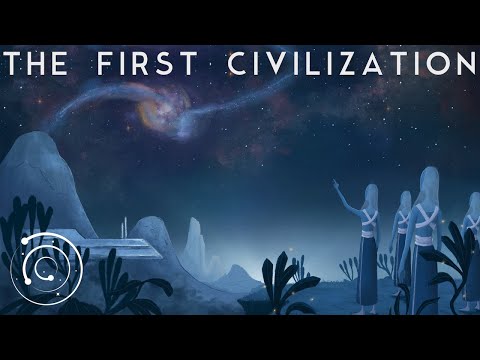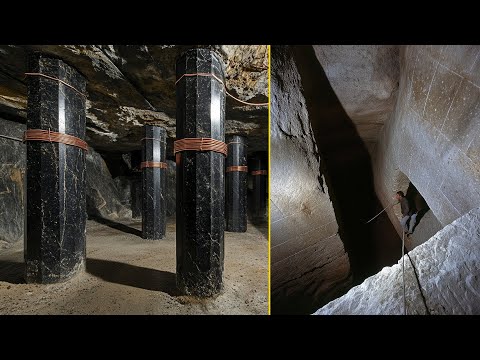The First Civilization to Emerge in the Galaxy

- The Milky Way: a galaxy that we call our home, but one that is unimaginably ancient. For some 13 billion years, it has drifted through of the cosmos, watching the very universe transform around it as well as changing herself. In many ways, the current era represents a kind of middle age for our galaxy. She's far less active than her wilder youth, maybe less magnificent to behold on a calm summer's night, having now swollen in a mass over the eons through the cannibalistic gluttony of neighboring galaxies. But like talking with a parent, we can't help but wonder what must those younger years have been like.
There are billions of other suns in the modern galaxy, possibly thousands of civilizations sprinkled across the swirling menagerie of stars around us. But what about those early times? What must it have been like to have lived in the formative years? What must it have been like to have been the first ones to awaken? We do not know when or even if other civilizations emerged in our galaxy, but to provide some context of what it must have been like, we're gonna dream of another civilization in those early years, a people that we'll call the Imins. They will serve as our vehicle, our guide to the science and conditions such a civilization may have faced. The story may be a fiction, but it allows us to work through the very real science of our early universe.
As we will see, though, being first isn't always as appealing as one might naively think. And in fact, it may even come lined with a certain sadness, a poignant tragedy to the whole affair. (winds whooshing) (gentle music) Let me take you back to a time 11 billion years ago. The Milky Way as we know it today does not yet exist, as it's still in the process of forming through the gradual mergers of many dwarf galaxies. The dominant actor of these mergers, known as the Milky Way Progenitor, is just 5% the mass of the modern galaxy, a seed of what one day will grow into the behemoth that we know today. Imin children would learn that their galaxy contains less than 10 billion stars and has a fairly typical clumpy shape, for the Milky Way's beautiful spirals had not yet formed either.
Looking at a star chart, the Imins would find themselves located near the outskirts of the proto Milky Way. To the Imins, this made perfect sense. Throughout this time, a much higher proportion of stars were massive stars, immense cosmic engines that would regularly explode in violent supernova. The radiation produced by such events is so powerful that it could extinguish entire planets of their resident life, even from distances of many light years away. Since the density of stars was much higher towards the galactic core, it made sense the Imin home world was near the edge, nestled within the the benign galactic suburbs, if you will. Stars were generally more massive than that of today, and so it's perhaps no surprise that the Imins lived on a world orbiting a bluer star than that of our own, for it was 60% more massive and thus burned hotter as a result.
Whilst humanity would classify the star as an F0 dwarf, the Imins never split stars up into such distinct classes. Rather, they thought of stars as part of a continuum. Because of this heavier star, the stellar luminosity was seven times greater than that of our sun, which explained why their planet was nearly three times further away from their star than the Earth is, for only here was it cool enough for liquid water to remain stable on the surface.
As a result of this greater distance, though, their star ironically appeared 40% smaller in their sky. Although the Imin home world received about the same amount of total radiation from their star as the Earth does, the radiation had a different profile, producing far more high energy radiation, in particular blue and ultraviolet light. In early years, this UV light kickstarted life and evolution, experiencing much faster mutation rates than those seen on the Earth. Life here soon developed photosynthesis, which came to thrive under this blue star, but so intense was the blue light component that many plants and indeed animals here had evolved blue pigmentation, reflecting some of the blue light away as there was simply too much otherwise. Having developed in such an environment, the Imins could recognize far more hues and tones of blue than we.
They had dozens of names for different shades that the human eye could ever even distinguish. Blue was seen as the color of life and red the color of death due to the color of the hemoglobin in their blood. Before the Imins developed technology or science, they would look up at the night sky and see it littered with blueish white stars that they interpreted to be living points of light penetrating the cosmos itself.
But they also saw reddish patches and blobs proliferating their sky, which they once believed was blood staining the heavens from battles between their mythical deities. Centuries later, the Imins would realize that these were in fact luminous star-forming regions, as stars were forming at rate roughly 30 times higher than the Milky Way that we know today. When the Imin astronomers first suggested this idea, they were considered heretics to many of their religious leaders with often dire punishments.
But over time, Imin culture accepted that these weren't regions of death, but rather regions of birth. The home world was about one third the mass of our Earth, which stemmed from the younger age of the universe itself. You see, the cosmos was just 2.8 billion years old, and so there had passed far less time for stars to manufacture the heavy elements needed to build rocky planets. Indeed, there was about 20 times less of the stuff than the modern era.
The Imin system was the fortuitous product of a particularly metal-rich star forming region some 2.5 billion years ago that was just 300 million years after the Big Bang itself. The region had enjoyed being fertilized with metals from numerous nearby first generation stars. And whilst many of the stars that formed subsequently were not well suited for life, the Imin star was.
But it was a lean system. The porosity of metals in the cosmos meant that giant planets hardly ever formed. Instead of a Jupiter, the Imin system's most massive planet was a roughly Earth-mass frozen wasteland in the outskirts of the system, and then a few of the minor dwarf planets scattered between them.
The Imin home world's lower mass had some important ramifications. Its smaller size meant that it cooled far quicker than the Earth, and so even though it was only 2.5 billion years old, Imin geologists believed that plate tectonics may soon shut off as the crust was in the process of forming a stagnant lid. The lower mass of course also meant a smaller physical size. It about 75% Earth's diameter, had 56% of the surface area, and a softer surface gravity of 63% that of the Earth.
We can imagine that Imins would've evolved with lighter frames and bones to we humans, perhaps having a slender, tall figure. Since surface pressure is proportional to gravity, the air would also be lighter on the surface too. With less oxygen to breathe, perhaps the Imins would've evolved a slower metabolism to adjust, perhaps even having multi-century lifetimes as a result of this. The lower surface gravity meant that the planet had a weaker hold on its atmosphere than the Earth, leading to a puffier gaseous envelope. As light passed through this deeper atmosphere, the greater column depth increased the absorption and scattering of light within it, leading to a bluer sky. This also led to more protection from the damaging ultraviolet radiation from their home star.
With a deeper atmosphere, the ozone layer afforded greater protection from UV light too. But even so, UV flux was significantly higher on the surface than that of the Earth. This radiation damages cells, rips apart genetic material, and threatens life so much that initially all life on the Imin planet had developed underwater or underground.
Eventually, the land was conquered though when a new genetic repair mechanism evolved that could repair both single and double-stranded DNA. Within the cells of all Imins, damaged DNA is moved to a compartmental ring-like structure where nucleotides from the the outside of the ring could then fuse and repair it. Many billions of years later, a similar mechanism would eventually be discovered on Earth within an extremophile bacteria known as Deinococcus radiodurans.
For thousands of years, Imin culture, society, and civilization flourished. They developed mathematics, science, astronomy, and studied the proto Milky Way around them. They discovered many wonders through these activities.
Amongst the billions of stars around them, they would witness countless supernovae, tidal disruption events, and watch stars wink out into black holes. The cosmos was gloriously generous when it came to high energy events. Within the center of their galaxy, they discover one gargantuan black hole and another slightly smaller one slowly spiraling into it. Further afield, they'd see a zoo of galactic mergers, galaxies binding, smearing, and stretching across space as gravity inexorably brought them together. To the Imins, the universe was a place of feverish change, a cosmos where merging and coagulation were a common theme, but a place that was inherently violent, dangerous, and largely hostile to life forms like themselves. In all of those wonders, the fervent maelstrom of activity, merging, and birth, the Imins eventually wondered were they alone? Imin astrobiologists had reasoned that stars like their own were the best place to look for life.
Specifically, they hypothesized that stars of similar mass to our sun would likely not produce enough high energy radiation to foster the rapid mutation rates that their planet had experienced, something that the Imins generally considered a necessity to enable intelligent life to one day evolve. Higher mass stars were also no good, surely too short-lived. After all, their own star was already approaching the end of its main sequence lifetime, and probably only had about half a billion years left before things turned sour. The Imins were an inherently deeply social species. Their slender form made them a frail people, one that only survived through cooperation with each other and their superior intellect over the rest of their biosphere. Solitary confinement was fatal to an Imin, so torturous that they would die in the face of prolonged absence of social contact.
For them, the search for life in the universe, for others like themselves, was a deeply seated compulsion. It wasn't just a scientific question. Their entire culture became increasingly organized around the search. The fear of being alone was so keen that whenever an Imin scientist warned that it was a possibility, it would spark mass outrage and backlash within their society.
Ironically, in the midst of their scientific search for alien life, this resistance nurtured a parallel vein of denialism and anti-science across the planet. Within their society, a sense of depression and anxiety grew as piece by piece, science began to hint that there was indeed something very special about their home. Some of this anxiety was countered by just sheer denialism, but at the same time, the underground use of narcotic compounds grew in popularity to provide a momentary reprieve.
Amongst these, most potently chlorofluorocarbons, or CFCs, had a unique and effective numbing effect on the Imin brain with apparently no side effects. This led to their eventual legalization and ultimately ubiquitous use across Imin society. This wonder drug soon found use in many parts of industry too, particularly for refrigeration and aerosol repellents, thanks to its low flammability and toxicity.
CFC production and use saw an unprecedented rise during these years and was aggressively marketed in a hope to quell public anxiety. Yet even numbed, the obsession for life in the universe was so strong that it dominated Imin culture by now. Across the planet, many states began to impose that schools cannot teach that there's anything unusual about the Imin home system, that it must be typical and life was therefore surely common, just waiting to be found. Eventually the mediocrity principle became a central dogma of the educational system, but in quiet moments many Imin scientists would admit despairing the forceful ignorance of the growing contrarian evidence. For by now, their astronomers had discovered that planets like their own were in fact incredibly rare and that much of the galaxy simply looked too violent for life.
Yet publishing such findings became increasingly difficult. The insatiable thirst for alien life was frequently exploited for personal gain by many members of Imin society. These bad actors would tell the world what they wanted to hear: that a nearby planet had alien structures on it, or they'd received a private radio communication from another star, or that they'd interacted with aliens or alien technology directly. Eventually, the truth of these fallacies was of course revealed, causing the anti-science sentiment to be propelled further as trust increasingly broke down between scientists and the public.
Around this time, a group of Imin meteorologists became alarmed at new observations of their planetary atmosphere. Their luscious, thick ozone layer that was so crucial in protecting their world from their star's high UV flux was seemingly disappearing. It was soon realized that the unthinkable was true: that the wonder drug that their society had become so addicted to was the root cause. CFCs were destroying ozone molecules and had already started to form a small hole above the planet's poles. Their work took years to finally get published, with many refusing to print such controversial findings.
But to the dismay of the scientists, the discovery was almost completely ignored, with society carrying on as usual and science outlets preferring to discuss the latest UFO sighting instead. Science literacy was so poor by now that many simply didn't understand the finding and certainly didn't like its implications. The Imin meteorologists were accused of performing mental gymnastics, or that this was simply a natural cycle, or that no ozone was actually fine because the planet didn't always have ozone when life once lived underwater anyway.
All the while, the hole in the ozone layer grew larger and larger. In these days, there was a historic meeting of Imin astronomers. They summarized decades of ultra precise searches for bio signatures and techno signatures as well as their deep understanding by now of the stellar population around them. The inescapable conclusion was that they were most likely alone, most likely the first.
Coupled with the pressing problems plaguing their society and ecosphere, any optimism for alien contact left the room that day. But some of the Imins at that meeting saw a solution, or at least one of a sort. They might not be able to have a two-way dialogue in the here and now, no, but they could have a one-way dialogue. Imins could preserve their knowledge, culture, and achievements and transmit it to future civilizations.
In that way, at least someone would know what they once did. Someone would know that at the very minimum, they once existed. In the years that followed, a growing movement came together for what became known as the Last Hope Project, a kind of time capsule design to preserve Imin knowledge and identity somehow across the stars, even if they were facing their imminent demise. It never became more than a minority, but these Imins desperately worked together through the possible options, ideas, and feasibility.
They worked tirelessly without pay or often sleep. Volunteers from across their globe came to help or just to try and support this Last Hope. As the ozone layer eroded across the planet, crop yields plummeted, leading to famine, ecological refugees, and regional conflicts over diminishing resources. Imins found themselves imprisoned within their homes during the day, unable to go outside under the harsh UV light.
At night, they'd wander outside and gaze up at the sky, still smeared with red blobs of star-forming regions, a reminder that they were too soon for this cosmos. The ultimate fate of the Imins, I leave to your imagination. But regarding their final dream, the Last Hope Project, I'll offer one last comment. The Imins were the first by quite a way, and their time capsule would go undiscovered for many billions of years. They knew that this was likely true, so had to design something that could last for eons without any moving paths, active power, or electronics, yet something that could somehow transmit information across the galaxy. And so the Imins placed a roughly 500 kilometer orbiting structure around their star, a thin sheet of material whose very shape would reveal its artificial nature.
As this sheet eclipsed in front of the star, distant civilizations might detect the dips in light and see something strange. Their first idea was to make it a triangle, something so obviously different from the shape of a planet that it would be clear that somebody built it. But for many Imins, that simply wasn't enough. A triangle didn't convey their science, their art, their philosophy, or what it was like to be an Imin.
And so the Imins devised a complex series of shapes, swirling geometries with nested structures. Like a fractal, one could begin with a coarse, zoomed out picture and learn some basic information. But the closer one looked, the more details, spokes, and nuanced structures would reveal themselves. In one of their greatest achievements, Imin mathematicians devised an ingenious way of encoding entire volumes of information within these intricate shapes.
However, the largest structure they could feasibly build was just 500 kilometers in length and width, but that was tiny compared to the size of their home star, blocking out less than 60 billionths of the star's brightness during the periodic eclipses. There wasn't much hope of anyone detecting that, let alone the intricate spokes and structure embedded within it. But the Imins had a long game. They knew that their star would die, eventually leaving behind a tiny white dwarf that would be not much bigger than their planet was. So if the structure survived until then, it would now block out a respectable 0.2% of the white dwarf's light, boosting the amplitude 34,000 fold.
Sadly, the Imins never saw the structure completed, but they did witness the launch of their automated 3D printers that would go on to construct their Last Hope in the centuries that passed. The final product wasn't perfect. In some places, the robots made mistakes without any guidance from their masters. Yet more, as the star eventually went giant, the radiation levels were higher than anticipated, deforming many of the most intricate geometries the Imins attempted to encode deep within their Last Hope.
But the basic shape remained, and within it one could decode sounds from their home world, messages from children across the planet, and extracts from their greatest poets and philosophers. Flash forward to 11 billion years later, the modern universe. The white dwarf that was once the Imins' home star has now cooled below 3,000 Kelvin, making it barely detectable except to infrared telescopes. In truth, the Imin structure was never conceived to last this long.
Over the eons, abrasion from dust, nucleonic decay, cosmic rays, and micro meteorites have battered it into a distorted, twisted sheet of metal floating through space. Perhaps many years later, we can imagine an astronomer detecting the dim light of this ancient white dwarf, a relic of the early universe. Squinting at that graph of brightness versus time, the astronomer might notice a dip in light, a strange decrease that didn't look planet-like.
Perhaps there's a held breath, a burrowed frow, and tension as the astronomer pushes the data through an interpreter, seeing what shape could this object possibly be? Maybe, just maybe this is the signal they've been looking for all these years. And then a sigh, another dud. It's just a cloud of randomly shaped material, probably just fragments of a broken up asteroid.
The screen shuts down. The astronomer leaves. And the Last Hope Project of the Imin planet is never detected again. The universe is vast, merciless, and largely hostile to living things. The Imin story that I presented to you is a fiction. We do not know if there was life so early in the cosmos, or indeed any time before now.
And quite likely alien life, if it exists at all, would be far more alien than I've imagined here, perhaps in ways that none of us can conceive. What I hope this video gives you is some insights into our early galaxy and the consequences of these differences on possible life. But also I hope that this video provides some reflection about the fragility of life and the path of our own civilization. Our story hasn't been written yet.
We get to choose what comes next. And much like the Imins, already we suspect that our planet may be very rare. Our fate, like theirs, is inexorably tied to how we treat it. The jewel of the solar system, perhaps even the galaxy. So until next time, stay thoughtful and stay curious. (warm music) Thank you so much watching, everybody.
I just wanna take a quick moment to give a big, big thank you to our latest Cool Worlds supporters. That is Graeme Benson, Nicholas Gebben, and the Rand Corporation. In fact, I'll be giving a talk at Rand in Santa Monica on March 7th. Details down below if you wanna see me in action. If you too wanna become a Cool Worlds supporter, then you click the link up above in the description.
If you haven't already, be sure to subscribe. And until next time, have a cosmically awesome day out there.
2022-02-13 10:56


